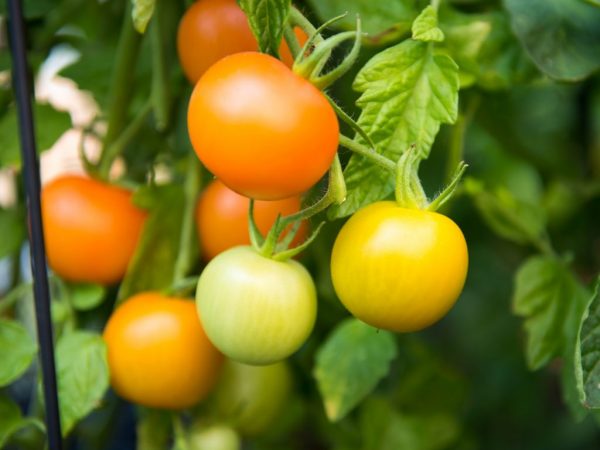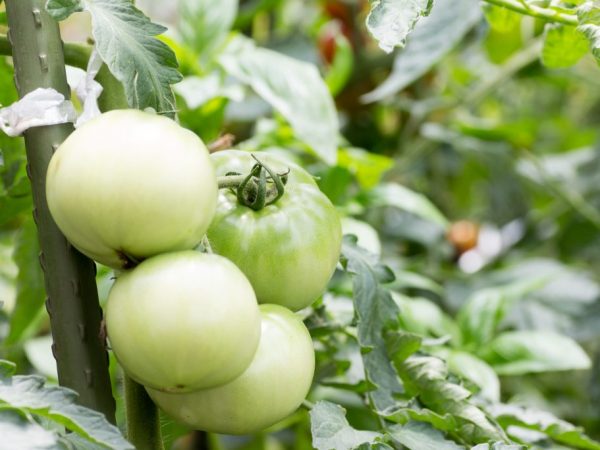Ways to accelerate the ripening of tomatoes in a greenhouse
Many people wonder why tomatoes in the greenhouse do not turn red and ripen poorly. There may be several reasons why tomatoes do not ripen in the greenhouse. Let's consider the main reasons in the article.

Ways to accelerate the ripening of tomatoes in a greenhouse
The ripening process of tomatoes
In the first 30 days after the ovary, the tomatoes grow at an accelerated rate, and the next 20-25 days they become poured and redden. A tomato is considered to be of high quality, which is poured and acquired a red color even in the garden, before harvesting. This is a sign that the tomato contains the whole range of nutrients and has excellent taste.
There are some types of tomatoes that are yellow or green in color. Check out the characteristics of the variety - perhaps it should not blush.
But if the variety should ripen in the garden, but it does not ripen on time, then there are certain reasons that arise when growing both in open ground and in greenhouse conditions.
Tatiana Orlova (Candidate of Agricultural Sciences):
There is another phenomenon as well. Gardeners may have noticed that a number of foreign varieties, which are mainly early-maturing varieties, are not tasty. They are low in sugars, they are dense, but lie for a long time. When breeding such varieties (or rather hybrids), they influenced the gene responsible for the color of the fruit. These hybrids turn red, and the red color of the tomato for us is an indicator of its ripeness when they are still in technical ripeness. That is, in fact, such fruits are still green, but already have a red color.
Reasons for the appearance of unripe tomatoes
If your tomatoes still do not turn red in an equipped greenhouse, you can conclude that they are missing something. What factors can interfere with the normal development of a vegetable crop and the fact that it does not ripen well?
- Air temperature. The optimum range is 22 to 29 ° C. With hypothermia or excessive heating in the vegetable, lycopene metabolism is lost. Tomatoes take on a bright yellow color and will no longer turn red.
- Excessive sunlight has a detrimental effect on the development of the plant: the fruits can simply burn out. However, tomatoes should not be kept in the dark either.
- Microclimate. Avoid high humidity levels in the greenhouse and extreme temperature fluctuations.
- Stocking density. The distance between the bushes should be at least 30 cm. Tightly planted to each other, the fruits ripen unevenly.
- Fertilizer. Excess nitrogen leads to a slowdown in ripening and coloring of the leaves in a gray-golden color. In turn, an insufficient amount of potassium in the soil leads to stiffening of the stems, which results in backwardness in the formation of tomatoes with a properly collected mass.
- Variety. For each climate zone, there are the most suitable varieties of tomatoes. In places with predominantly cold weather, preference is given to early maturing varieties.
Tatiana Orlova (Candidate of Agricultural Sciences):
In the cold regions of the country, where the growing season is short, it is possible to grow varieties not only early in terms of ripening, but also with a friendly return of the harvest.In such varieties, only 1-2 brushes are laid, all stepchildren who take away the nutrition of the plant are promptly removed. This allows you to get a full harvest before the onset of stable cold weather.
Stimulation of maturation

Follow the recommendations
There are recommendations that can speed up the ripening of tomatoes in the greenhouse:
- Iodine deficiency will help to make up for foliar feeding from a solution of iodine (35 drops) per 10 liters of boiled water.
- In the fall, plants cannot get enough sunlight. To provide your tomatoes with the warmth of the rays as much as possible, cut off all excess leaves from the bush and turn it towards the sunny side. Remove all obstructions from the rays. Budding during cold weather is rather unpromising, therefore, it is recommended to carefully remove flowering buds. New fruits are unlikely to have time to ripen before the onset of cold weather. When they come, move the plants to the warmest corner of the greenhouse or cover with a cloth to keep them warm.
- Grassing and trimming the brushes will also help when the vegetable does not ripen evenly. Prune leaves and shoots to areas where the fruits are already ripening and have had time to fill, and new ones will not form. In this way, you will save more food for the fetuses in need, and they will begin to develop faster.
- To protect plants from infection, which can also cause immaturity, treat the leaves with protective solutions: vitriol or folk methods, garlic water diluted with alcohol - 2-3 times for a week and a half.
- If tomatoes do not turn red well in the greenhouse, ethyl alcohol helps to speed up the process. You need to sprinkle a few drops of it close to the tomato root. In the near future, the fruits that are lagging behind in development will catch up with the already ripe specimens and will develop faster in the future.
- A popular procedure among vegetable growers is cutting back on the metabolism of the upper and lower sides of the bushes. To do this, the stem of the tomatoes is cut and a metal wire is inserted into it.
- If you put an unripe fruit next to a ripe tomato, then after a while it will ripen faster thanks to ethylene. The statement is not scientific, but you can still try to speed up ripening and redness in this way.
Care features
If all the tomatoes in the greenhouse do not turn red, improper care is the culprit. In rare cases, it is the flaws of the variety itself.
Growing in a greenhouse has its own nuances. High humidity does not have a very good effect on the formation of fruits, although they like the soil abundantly moistened. Therefore, make sure that the level does not exceed the norm.
No amount of artificial lighting can replace a plant's natural light source. Still, try to provide the maximum that special lamps for greenhouses can give.
You can make the tomatoes ripen at the same time, subject to the following rules:
- watering the soil: frequent, but dosed;
- fertilization of the soil: alternation of organic matter and minerals, the basis of nutrition is phosphorus, nitrogen and potassium dressings;
- weeding, weeds removed in time will facilitate widespread growth and development for nightshade culture;
- pinching and garter: removing unnecessary shoots and forming stems is a condition for obtaining a neat bed;
- spraying: late blight, viral tobacco mosaic and gray rot are the main enemies of tomatoes.
Conclusion
Pick up zoned tomato varieties. They must be suitable for growing in your climate zone so that they ripen on time.
In order for all specimens to ripen on time, it is enough to simply adhere to the general rules for caring for tomatoes and be conscientious about your business.



